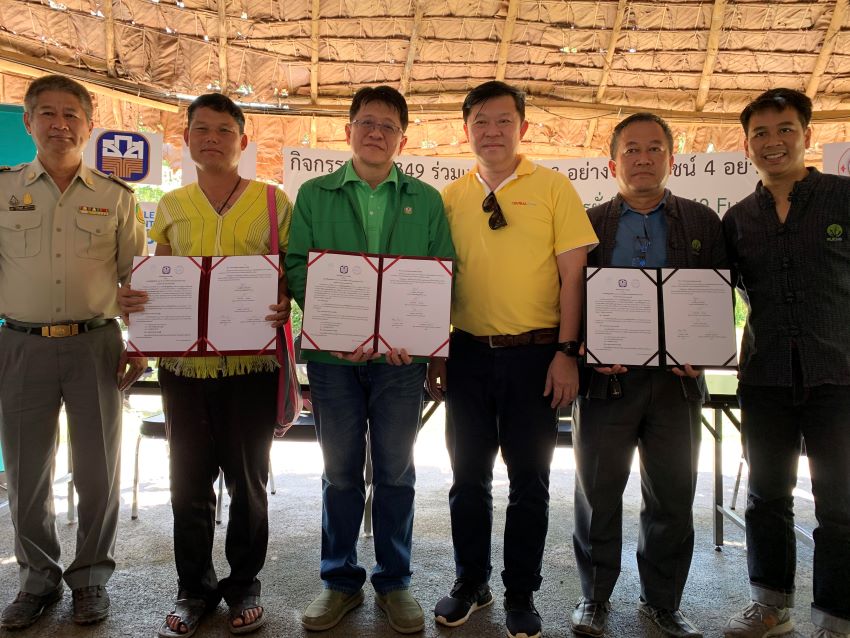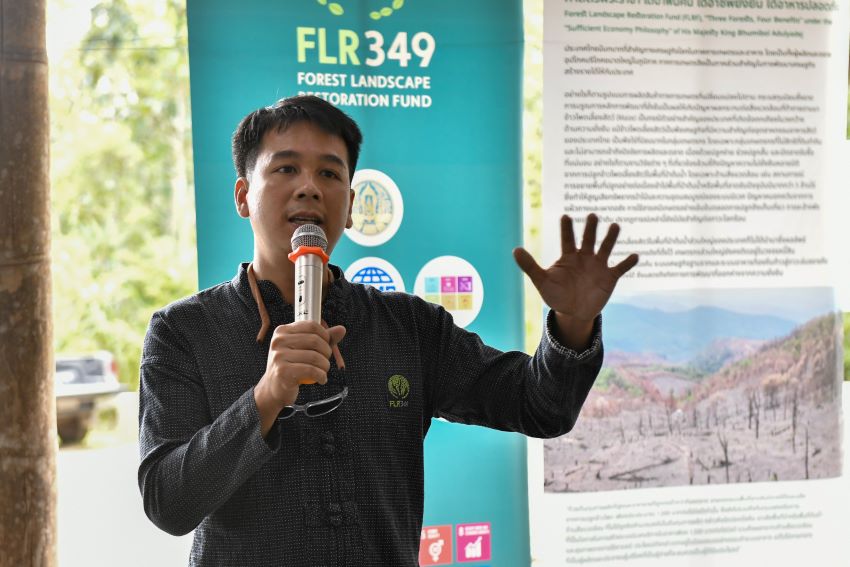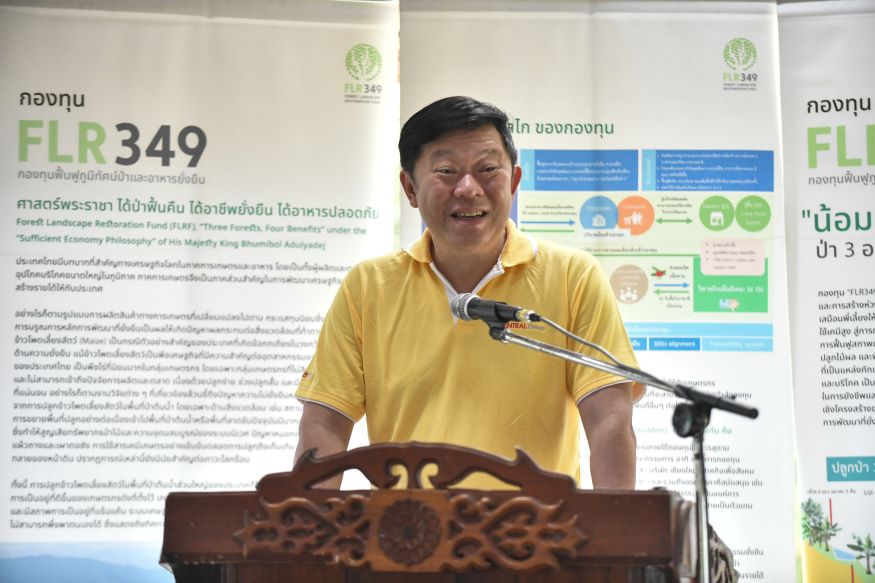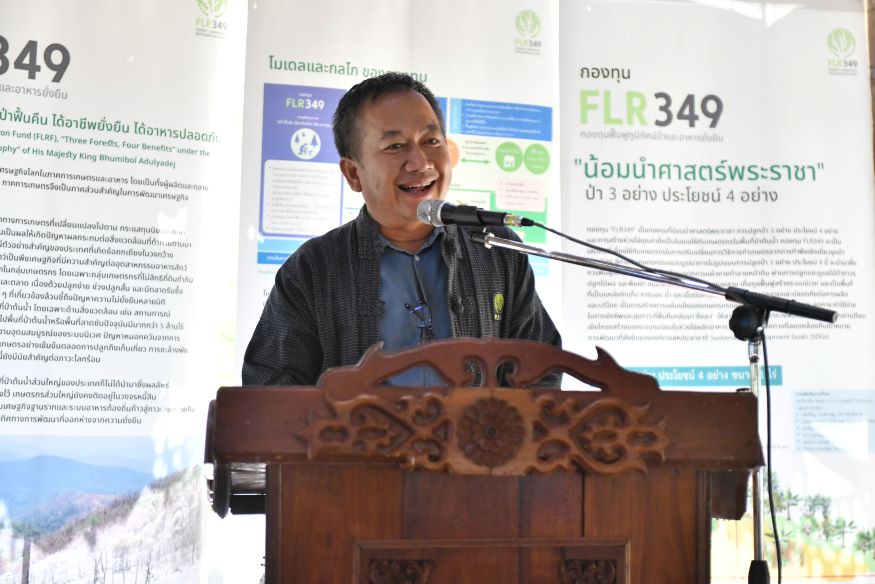The WWF is run at a local level by the following offices...
- WWF Global
- Adria
- Argentina
- Armenia
- AsiaPacific
- Australia
- Austria
- Azerbaijan
- Belgium
- Bhutan
- Bolivia
- Borneo
- Brazil
- Bulgaria
- Cambodia
- Cameroon
- Canada
- Caucasus
- Central African Republic
- Central America
- Chile
- China
- Colombia
- Croatia
- Democratic Republic of the Congo
- Denmark
- Ecuador
- European Policy Office
- Finland
FLR349: Restoring watershed areas and fighting the climate crisis in Mae Chaem
11 October 2019
11th October 2019 Mae Khi Muk village, Ban Thap sub-district, Mae Chaem district, Chiang Mai province

Today, representatives from different sectors and around 100 people planted trees as part of a forest restoration model using the “Three Forests, Four Benefits” concept. The project announced the goal of reforesting 50,000 rai within ten years and halting chemical-intensive monoculture maize farming, in a drive to restore watershed areas and fight the climate crisis, following His Majesty King Bhumibol Adulyadej’s philosophy of sufficiency economy.
The Forest Landscape Restoration 349 Fund model (FLR349) is a collaborative effort between WWF Thailand, the Thai Organic Agricultural Innovation Foundation (TOF), the Bank for Agriculture and Agricultural Cooperatives (BAAC), Rajamangala University of Technology Lanna (RMUTL), and retail stakeholders including the Central Group. FLR349 was first implemented at the Mae Chaem project site in 2018. Here, 67 smallholder families on 198 rai of land are increasing agroecological practices, shifting away from maize and field burning, and applying the philosophy of sufficiency economy. Currently, the model focuses on restoring healthy watershed ecosystems, improving the quality of life and food security for smallholders, and mitigating climate change.
The event was attended by representatives from different sectors including the Royal Forest Department, the local administrative organisation officers, the financial institution, academics, organic agriculture networks, the private sector, and smallholders. Activities included a progress report, setting of joint objectives and goals, and a talk on organic agriculture and forest landscape restoration. The participants planted different types of trees such as perennials, cacao, and banana, following the “Three Forests, Four Benefits” concept.
“The FLR349 Fund model aims to restore 50,000 rai of forests in 10 years while supporting the wellbeing of smallholders and increasing their income by 40% through organic agriculture and creating green spaces by planting perennials and fruit trees. The model also develops sustainable food chains and traceability measures. In addition to this, the FLR349 fund is a measure against climate change in the agriculture sector, which is an issue that needs to be addressed urgently,” said Ply Pirom, Sustainable Production and Consumption Project Manager at WWF Thailand.

“The Central Group is proud to contribute to this cause of creating jobs, improving people’s wellbeing, and supporting a sustainable environment. The FLR349 Fund is another project that the private sector is investing in to push forward reforestation efforts and implement measures to combat increasingly severe climate change,” said Pichai Chirathivat, Executive Director of the Central Group.

“At the pilot areas in Chiang Mai and Nan we have already planted 83,500 trees of 17 different species. The three types of trees, which are trees for use at home, trees for edible products, and trees for commercial timber, provides the four benefits of shelter, resources, food, as well as the restoration and conservation of the environment and ecosystems – together this provides a model for reforestation. Achieving our goal of 50,000 rai requires a substantial amount of funding, so we invite all sectors to help us achieve this goal,” said Rattapat Srichanklad, FLR349 Fund Secretary.

About the FLR349 Fund
*FLR349 Fund is a fund that has been developed based on the King’s Philosophy of “Three Forests, Four Benefits” and the development of a value chain which could become a model for farmers living in watershed areas. The FLR349 Fund helps farmers turn their agricultural operations from forest-encroaching mono-agriculture with intensive use of chemicals into the “Three Forests, Four Benefits” agricultural system which helps to restore the environment by stopping the destruction of top soil. Farmers learn to grow perennial trees, fruit trees, vegetables and herbs in a mixed system that is sustainable, and which replenishes the soil. Such plantations function like carbon sinks and water reservoirs which make possible the production of diverse and safe foods for consumption. It helps to empower farmers and their community, helps to reduce their living expenses, and helps to keep them healthy. As a result, they can break free from the endless cycle of debt that has trapped many farmers in in our current food system. This system is consistent with the UN Sustainable Development Goals (SDGs).
To download more information about the FL349 model, visit: http://scp.wwf.or.th/news_stories/?uNewsID=335495
About World Wide Fund for Nature (WWF)
For nearly 60 years, WWF has been protecting the future of nature.
The world’s leading conservation organization, WWF works in 100 countries and is supported by more than one million members in the United States and close to five million globally. WWF's unique way of working combines global reach with a foundation in science, involves action at every level from local to global, and ensures the delivery of innovative solutions that meet the needs of both people and nature.
For more information, visit: www.panda.org/news
Contact information:
Ms. Duangkamol Wong
Conservation Marketing and Communications Manager
T: 02-618-4303-05 #107
E: Dwongworachan@wwf.or.th

Today, representatives from different sectors and around 100 people planted trees as part of a forest restoration model using the “Three Forests, Four Benefits” concept. The project announced the goal of reforesting 50,000 rai within ten years and halting chemical-intensive monoculture maize farming, in a drive to restore watershed areas and fight the climate crisis, following His Majesty King Bhumibol Adulyadej’s philosophy of sufficiency economy.
The Forest Landscape Restoration 349 Fund model (FLR349) is a collaborative effort between WWF Thailand, the Thai Organic Agricultural Innovation Foundation (TOF), the Bank for Agriculture and Agricultural Cooperatives (BAAC), Rajamangala University of Technology Lanna (RMUTL), and retail stakeholders including the Central Group. FLR349 was first implemented at the Mae Chaem project site in 2018. Here, 67 smallholder families on 198 rai of land are increasing agroecological practices, shifting away from maize and field burning, and applying the philosophy of sufficiency economy. Currently, the model focuses on restoring healthy watershed ecosystems, improving the quality of life and food security for smallholders, and mitigating climate change.
The event was attended by representatives from different sectors including the Royal Forest Department, the local administrative organisation officers, the financial institution, academics, organic agriculture networks, the private sector, and smallholders. Activities included a progress report, setting of joint objectives and goals, and a talk on organic agriculture and forest landscape restoration. The participants planted different types of trees such as perennials, cacao, and banana, following the “Three Forests, Four Benefits” concept.
“The FLR349 Fund model aims to restore 50,000 rai of forests in 10 years while supporting the wellbeing of smallholders and increasing their income by 40% through organic agriculture and creating green spaces by planting perennials and fruit trees. The model also develops sustainable food chains and traceability measures. In addition to this, the FLR349 fund is a measure against climate change in the agriculture sector, which is an issue that needs to be addressed urgently,” said Ply Pirom, Sustainable Production and Consumption Project Manager at WWF Thailand.

“The Central Group is proud to contribute to this cause of creating jobs, improving people’s wellbeing, and supporting a sustainable environment. The FLR349 Fund is another project that the private sector is investing in to push forward reforestation efforts and implement measures to combat increasingly severe climate change,” said Pichai Chirathivat, Executive Director of the Central Group.

“At the pilot areas in Chiang Mai and Nan we have already planted 83,500 trees of 17 different species. The three types of trees, which are trees for use at home, trees for edible products, and trees for commercial timber, provides the four benefits of shelter, resources, food, as well as the restoration and conservation of the environment and ecosystems – together this provides a model for reforestation. Achieving our goal of 50,000 rai requires a substantial amount of funding, so we invite all sectors to help us achieve this goal,” said Rattapat Srichanklad, FLR349 Fund Secretary.

About the FLR349 Fund
*FLR349 Fund is a fund that has been developed based on the King’s Philosophy of “Three Forests, Four Benefits” and the development of a value chain which could become a model for farmers living in watershed areas. The FLR349 Fund helps farmers turn their agricultural operations from forest-encroaching mono-agriculture with intensive use of chemicals into the “Three Forests, Four Benefits” agricultural system which helps to restore the environment by stopping the destruction of top soil. Farmers learn to grow perennial trees, fruit trees, vegetables and herbs in a mixed system that is sustainable, and which replenishes the soil. Such plantations function like carbon sinks and water reservoirs which make possible the production of diverse and safe foods for consumption. It helps to empower farmers and their community, helps to reduce their living expenses, and helps to keep them healthy. As a result, they can break free from the endless cycle of debt that has trapped many farmers in in our current food system. This system is consistent with the UN Sustainable Development Goals (SDGs).
To download more information about the FL349 model, visit: http://scp.wwf.or.th/news_stories/?uNewsID=335495
About World Wide Fund for Nature (WWF)
For nearly 60 years, WWF has been protecting the future of nature.
The world’s leading conservation organization, WWF works in 100 countries and is supported by more than one million members in the United States and close to five million globally. WWF's unique way of working combines global reach with a foundation in science, involves action at every level from local to global, and ensures the delivery of innovative solutions that meet the needs of both people and nature.
For more information, visit: www.panda.org/news
Contact information:
Ms. Duangkamol Wong
Conservation Marketing and Communications Manager
T: 02-618-4303-05 #107
E: Dwongworachan@wwf.or.th